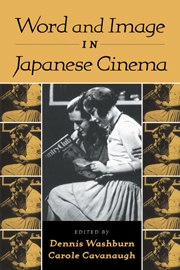Book contents
- Frontmatter
- Contents
- List of Illustrations
- Contributors
- Foreword: Outside Views of the Japanese Film
- Introduction
- PART ONE WORDING THE IMAGE/IMAGING THE WORD
- 1 The Word before the Image: Criticism, the Screenplay, and the Regulation of Meaning in Prewar Japanese Film Culture
- 2 The Cinematic Art of Higuchi Ichiyô's Takekurabe (Comparing Heights, 1895–1896)
- 3 Once More and Gosho's Romanticism in the Early Occupation Period
- 4 The Taunt of the Gods: Reflections on Woman In The Dunes
- 5 Adapting The Makioka Sisters
- 6 In the Show House of Modernity: Exhaustive Listing in Itami Jûzô's Tanpopo
- PART TWO REFLECTIONS OF IDENTITY
- PART THREE OUTSIDE THE FRAME OF CULTURE
- Selected Bibliography of Articles and Books in English
- Index
1 - The Word before the Image: Criticism, the Screenplay, and the Regulation of Meaning in Prewar Japanese Film Culture
Published online by Cambridge University Press: 01 March 2010
- Frontmatter
- Contents
- List of Illustrations
- Contributors
- Foreword: Outside Views of the Japanese Film
- Introduction
- PART ONE WORDING THE IMAGE/IMAGING THE WORD
- 1 The Word before the Image: Criticism, the Screenplay, and the Regulation of Meaning in Prewar Japanese Film Culture
- 2 The Cinematic Art of Higuchi Ichiyô's Takekurabe (Comparing Heights, 1895–1896)
- 3 Once More and Gosho's Romanticism in the Early Occupation Period
- 4 The Taunt of the Gods: Reflections on Woman In The Dunes
- 5 Adapting The Makioka Sisters
- 6 In the Show House of Modernity: Exhaustive Listing in Itami Jûzô's Tanpopo
- PART TWO REFLECTIONS OF IDENTITY
- PART THREE OUTSIDE THE FRAME OF CULTURE
- Selected Bibliography of Articles and Books in English
- Index
Summary
RENAMING THE UNNAMED
Despite the predominant tendency to term motion pictures an image medium both in the West and in Japan (where eizô [image] is in fact coming to supplant the word eiga [film] for many educational institutions offering film courses), the word both spoken and written has played a central role in the history of the art. This is not simply due to the perfection of sound technology in bringing speech to the screen; there is also a long history of cinema inspiring, and in turn being inspired by, writing. The relationship between film and literature is certainly the most prominent example of such interaction between word and image, but it would be restricting to reduce our conception of such intercourse to only literary adaptation in cinema or to the “visuality” of the modern novel. Both inquiries assume a cinema-image/literature-word dichotomy that occludes the historical role writing and speaking about cinema has played in the constitution of the medium itself and of how it has operated in prewar Japanese film culture.
One could consider, for instance, the history of the importation and assimilation of cinema in Japan itself as the attempt to articulate a foreign object into the domestic language, of naming what had not yet been named. The creation of the medium's initial Japanese appellation, katsudô shashin (literally, “moving photographs”), or the lectures given by the first benshi (benshi is another term for “Katsuben” the film explainer or narrator whose words accompanied a film) to explain the newly arrived wonder, can be taken as manifestations of this discursive process of introducing audiences to an unknown technology.
- Type
- Chapter
- Information
- Word and Image in Japanese Cinema , pp. 3 - 35Publisher: Cambridge University PressPrint publication year: 2000
- 1
- Cited by

